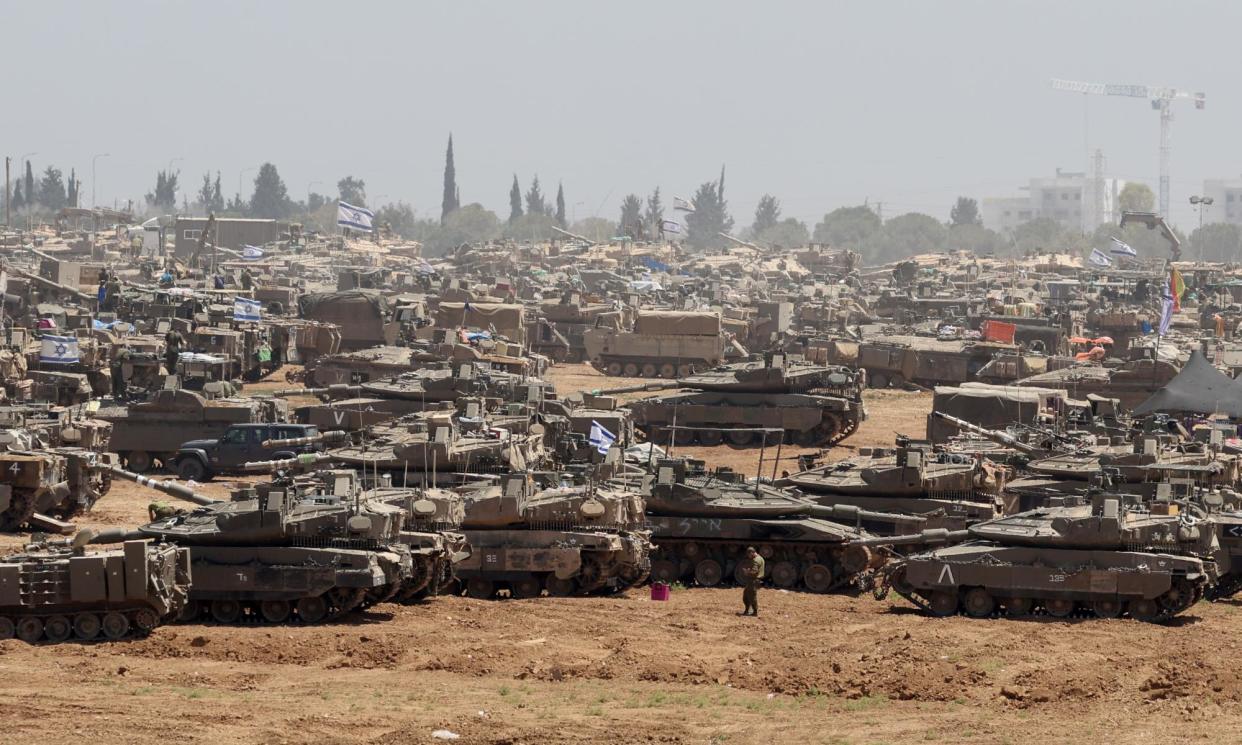Does Israel need more US arms for a Rafah offensive?

Photograph: Abir Sultan/EPA
The volume of US military aid to Israel since 7 October last year suggests the intensity of the assault on Gaza would not have been possible without the continued supply of American bombs, shells and other munitions, some of which the US president, Joe Biden, is now threatening to halt after seven months of the fighting.
Precise figures are hard to come by, partly because the US is careful to keep shipments below disclosable limits and can rely on old congressional approvals, sometimes dating back many years, to send arms without the need for fresh authorisation. But even the limited disclosure reveals their significance.
Officials privately told Congress in March that more than 100 separate foreign military sales had been made to Israel since 7 October, and one US thinktank reported that the Pentagon had “sometimes struggled to find sufficient cargo aircraft to deliver the systems” because so much was waiting to be shipped over.
A standing 10-year agreement, signed by Barack Obama, as US president, in 2016, has allowed for the provision of $3.3bn a year in arms since 2018, plus a further $500m a year for air defence systems. On top of that Congress approved a further $13bn worth of military aid last month, including $5.2bn to bolster existing air defences.
It is a security relationship that began in the 1960s, and the US has provided more than $123bn of military aid to date. Of Israel’s arms imports, 69% comes from the US, according to the Stockholm Peace Research Institute, and pauses have been very rare. Ronald Reagan, as US president, once held up the transfer of F-16 fighters in 1982, unhappy that Israel had invaded Lebanon.
During the current conflict the Pentagon has only occasionally published details of the aid it has sent: $320m in precision bomb kits in November, and in December 14,000 tank shells costing $106m, and $147.5m for 57,000 155mm artillery shells and their fuses and primers, plus 30,000 howitzer charges.
Meanwhile, Israel’s air force said that in mid-February it had struck targets 29,000 times in Gaza, a little over four months into the conflict, in its efforts to eliminate Hamas. It is part of a strategy of saturation bombing that has killed 34,780 Palestinians, according to the territory’s health ministry.
A surprise was that the US was even considering supplying the 1,700 500lb bombs and in particular the 1,800 2,000lb bombs now paused by Biden. A 2,000lb bomb, four times heavier than the largest bombs used by the US against Isis in Mosul, is powerful enough to blow up a small apartment block and leave behind a crater 12 metres wide.
The US presumption was that these crude, heavy, weapons, capable of killing dozens or more in a crowded area, were going to be used in a final Israeli assault on Rafah. “Civilians have been killed in Gaza as a consequence of those bombs and other ways in which they go after population centres,” Biden told CNN on Wednesday night.
Previously, 2,000lb bombs were believed to have been used in strikes such as at the Jabaliya refugee camp on 31 October, where it is estimated that at least 116 civilians were killed. Another estimate, by CNN, using satellite imagery, concluded that 500 large impact craters had appeared in Gaza during the first month of the war to 6 November, consistent with the use of 2,000lb munitions.
The question is, without the larger US bombs, how many do the Israel Defense Forces (IDF) have stockpiled? It is not a question that is easy to answer. In response to the 7 October attack the US opened up access to its own arms stockpile in Israel, WRSA-I, which could have had up to $4.4bn worth of munitions of various types in it, according to a congressional research estimate.
The reality is that the limited category of weapons covered by the Biden pause leaves other weapons types apparently available to Israel, including tank rounds and artillery shells. Israel’s air force remains largely unaffected; 25 more F-35 fighters were approved for sale in March, part of a deal authorised by Congress in 2008.
In the short term, Israel is almost certainly able to go ahead, if it chooses to, with its threatened offensive in Rafah, despite the acute humanitarian crisis it is almost certain to cause among the million Palestinians desperately sheltering there. But that would risk deepening the military supply rift with the US.
An analysis from the conservative Foundation for Defense of Democracies, in Washington DC, suggests that Israel, which last year spent 5.3% of its GDP on defence (more than two and a half times the Nato target) would have to lift budgets to between 7% and 8% “to reduce (not eliminate) its reliance on foreign governments for the weapons Israel most needs”. It is not clear if that is sustainable.


